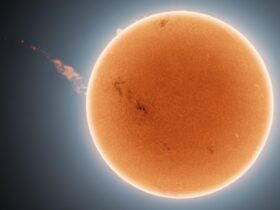The most catastrophic event in our planet’s history in terms of biomes was the mass extinction that followed an enormous asteroid impact. It is the same asteroid that wiped out the dinosaurs. However, the disappearance of the dinosaurs let mammals boom and flourish. It is one of the reasons why our species exists.
Since we’ve come so far as a species, it would be desirable to avoid future asteroid calamities.
99942 Apophis is the name of one of the most threatening space rocks in our galaxy.
It is a large rocky object estimated at 1,000 feet in width, and it is huge enough to produce catastrophic damage should it hit our planet.
It will pass our planet on Friday, March 5.
The good news is that the space rock won’t hit our planet.
You may have heard about the asteroid some time ago because it made the headlines when scientists couldn’t figure out if it will collide with our planet when it passes nearby in 2029.
The better news is that it won’t hit us in 2029 either!
The space rock will put on quite a show for both amateur and professional skywatchers this Friday. Apophis is big enough to be observable by higher-end hobbyist gear.
It is dozens of times farther away from our planet than the Moon, but that won’t repeat in 2029 when it will be much closer. It will pass by our planet closer than many distant Earth-orbiting satellites are located.
“At its farthest, Apophis can reach a distance of about 2 astronomical units (One astronomical unit, abbreviated as AU, is the distance from the Sun to Earth.) away from Earth. It’s expected to safely pass close to Earth – within 19,794 miles (31,860 kilometers) from our planet’s surface – on April 13, 2029. This is the closest approach by an asteroid of this size that scientists have known about in advance,” NASA explained.












Leave a Reply